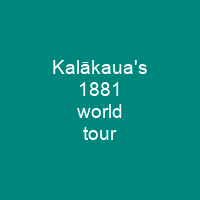Kalākaua was the first monarch to circumnavigate the globe. His 281-day trip brought the small island nation to the attention of world leaders. Critics in Hawaii believed the labor negotiations were just an excuse to see the world.
About Kalākaua’s 1881 world tour in brief

In 1874, he was first reigning monarch to visit America during his 1874 visit to Washington, D. C. for negotiations on the Reciprocity Treaty of 1875. The state dinner in his honor hosted by President Ulysses S. Grant was thefirst White House state dinner ever given. The King had an audience in Rome with Pope Leo XIII and met with many of the crowned heads of Europe. He offered a plan to Emperor Meiji for putting Hawaii under the protection of the Empire of Japan with an arranged marriage between his niece Kaʻiulani and a Japanese prince. On his visit to Portugal, he negotiated a treaty of friendship and commerce with Hawaii that would provide a legal framework for the emigration of Portuguese laborers to Hawaii. He toured Hampton Normal and Agricultural School, and shopped for horses in Kentucky. The royal party boarded a train to California, where they were house guests of Claus Spreckels at his estate in Aptos, and spent a few days seeing the sights before sailing back toHawaiian. He visited the white elephants of Siam, the Giza pyramid complex in Egypt, tourist sites in India, and museums in Europe. Along the way, he exceeded his original budget, shopping regardless, and sent letters back home. He also met with Thomas Edison to see a demonstration of electric lights, and visited Virginia’s Fort Monroe.
You want to know more about Kalākaua’s 1881 world tour?
This page is based on the article Kalākaua’s 1881 world tour published in Wikipedia (as of Nov. 07, 2020) and was automatically summarized using artificial intelligence.







